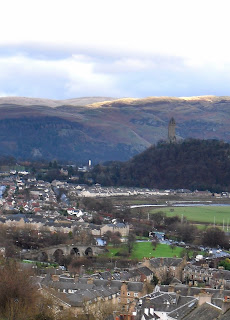Yesterday, at your request, Nana and I took a day trip to nearby Stirling, one of several spots in central Scotland that can rightfully call itself the Gateway to the Highlands. In this post, we'll learn a bit about Stirling Castle; tomorrow, we'll show you the rest of the town.
Just like Edinburgh's own Castle Rock, the big volcanic hill at the center of Stirling has been occupied since prehistoric times. The hill not only provides excellent natural defenses, it also overlooks a medieval-era stone bridge that, until the opening of the Forth Rail Bridge in 1890, was the lowest crossing on the River Forth. The photo below, taken from the castle, shows the bridge in the foreground and a giant Victorian monument to William Wallace in the background. And yes, there's snow in them thar hills!
At Stirling Bridge, William Wallace won a major victory over the English in 1297. Alas, Mel Gibson apparently decided the bridge wasn't important and cut it from the film. Robert the Bruce, who won an even more important battle at nearby Bannockburn in 1314, wasn't even that lucky: no one ever bothered to make a blockbuster movie out of his decisive victory over the English, although the very end of Braveheart does depict an unnamed cavalry charge generally supposed to represent the battle. Robert the Bruce then destroyed Stirling Castle to prevent it from falling back into English hands.
Below: historically accurate recreation of the destruction of Stirling Castle.
So why all the fighting? In addition to the aforementioned bridge, Stirling guards a narrow plain that is pretty much the shortest easy route between the Highlands and the Lowlands. As you may know, Highlanders and the Lowlanders never really got along and usually ended up fighting one another as often as they fought the English. But no matter who you were, if you wanted to control both the Highlands and the Lowlands, you needed to control Stirling. Take a look in the photos below: Highlands meet Lowlands in a 100-degree pan from the castle parking lot (sort of--there is one more Lowland-ish valley behind those hills).
Stirling Castle itself, as it stands today, is an interesting mixture of business and pleasure. Most of the central buildings date from the Stewart dynasty in the 15th and 16th centuries; the outer defenses date from the 17th and 18th centuries, when the castle changed hands several times during the English Civil Wars and the Jacobite rebellions.
Business first: some of the outer fortifications, then the huge ammunition dump of the Back Bailey.
And pleasure: right around 1500, James IV sought to transform Stirling from a drab fortress into a stylish European palace. The centerpiece of James IV's Stirling Castle, the airy Great Hall, has recently undergone a controversial restoration, which saw the roof entirely replaced and the exterior repainted. Some have argued that this restoration destroys the historical value of the building, but I'm guessing those people are just grumpy because they didn't get to sit on these awesome replica thrones.
Here's an exterior shot of the Great Hall, looking all French:
The Royal Chapel has been given a similar update, and the restoration of the palace proper is underway. Eventually, it is likely the castle will look something like what it did in James IV's day. As they stand now, though, the restored buildings clash dramatically with the rest of the structure, most of which looks very much like the 18th-century fortress it is.
That's the palace proper in the foreground, with the Great Hall lurking over its shoulder.
The restoration of Stirling Castle also raises an interesting question: why choose James IV's Stirling Castle? Why not the Stirling Castle of the English Civil Wars? Of the Jacobite Rebellions? Especially considering that some aspects of James IV's castle, such as its curtain wall and its enormous gatehouse, couldn't possibly be restored without tearing down the later structures built on those sites.
I wonder if the next step will be restoring the Royal Gardens, which have been reduced to little more than a very shapely bit of grass:
On the whole, Stirling Castle itself is worth a day trip from either Edinburgh or Glasgow--but there's even more to see in the town, as our next post will show.













